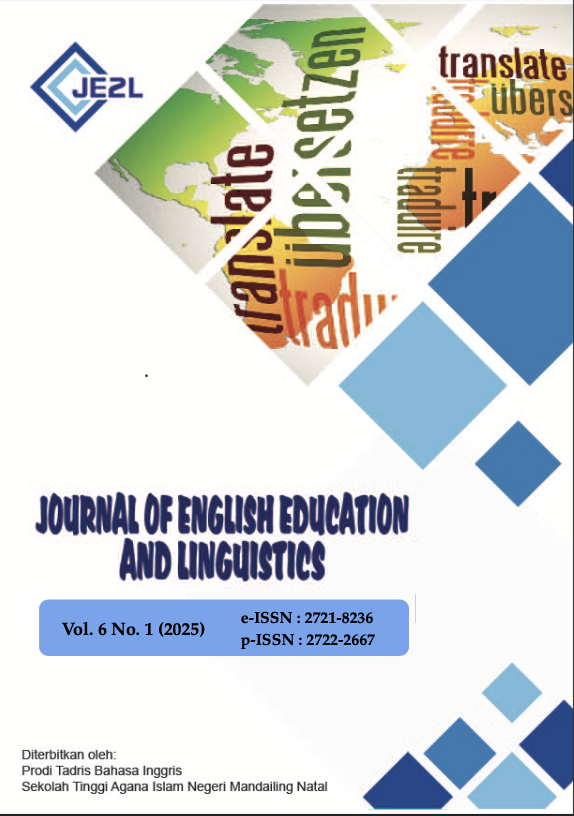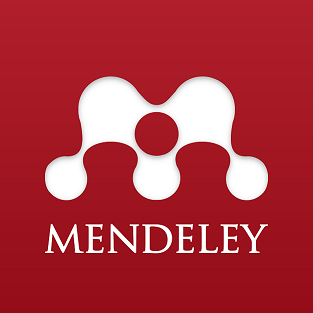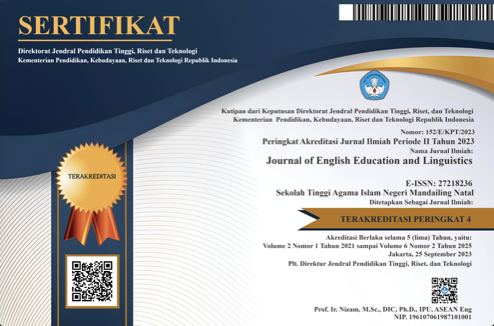STUDENTS' PERCEPTIONS OF THE USE OF DIGITAL MEDIA IN ENGLISH LANGUAGE LEARNING
DOI:
https://doi.org/10.56874/jeel.v6i1.2289Keywords:
Students’ Perceptions, Digital Media, English Language LearningAbstract
This study examines students' perceptions of the use of digital media in English language learning at Teacher Training and Education College of Insan Madani. Using a qualitative research approach, data were collected through semi-structured interviews with students enrolled in English language courses. The findings indicate that students perceive digital media as an effective and flexible tool that enhances their language acquisition. Platforms such as YouTube, Duolingo, Zoom, Google Classroom, and WhatsApp were particularly valued for their ability to provide authentic English exposure, interactive learning experiences, and opportunities for autonomous learning. However, despite the benefits, students also identified several challenges, including limited internet access, digital literacy gaps, and distractions from non-educational content. The study suggests that a blended learning approach, combining digital media with structured classroom instruction, could help mitigate these challenges and maximize the benefits of technology in English language learning. Additionally, institutions should focus on enhancing digital literacy training and improving internet accessibility to support students in effectively utilizing digital tools. This research contributes to the ongoing discourse on technology-enhanced language learning, particularly within the context of Islamic teacher training institutions, and provides insights for future studies on optimizing digital media use in English education.
References
Almusharraf, N., & Khahro, S. (2020). Students’ Perceptions of E-learning amid the COVID-19 Pandemic: A Study of Higher Institutions in Saudi Arabia. Education and Information Technologies, 25(6), 5801-5820.
Braun, V., & Clarke, V. (2006). Using Thematic Analysis in Psychology. Qualitative Research in Psychology, 3(2), 77-101.
Bryman, A. (2016). Social Research Methods (5th ed.). Oxford University Press.
Creswell, J. W., & Poth, C. N. (2018). Qualitative Inquiry and Research Design: Choosing Among Five Approaches (4th ed.). SAGE Publications.
Hsu, L. (2021). Challenges of Digital Learning in English Language Education: Perspectives from Students and Teachers. Journal of Language and Education Technology, 8(1), 67-81.
Rahman, A., & Arif, M. (2021). Digital Divide in Education: The Impact on English Language Learners. Journal of Educational Research and Innovation, 10(3), 110-125.
Sun, Y., & Yang, X. (2020). Digital Media and Autonomous Learning in EFL Classrooms: A Longitudinal Study. Educational Technology & Society, 23(4), 89-103.
Wang, J., & Winstead, L. (2022). The Impact of Digital Learning Tools on English Language Proficiency: A Meta-Analysis. Journal of Applied Linguistics and Language Research, 9(3), 120-135.
Zhang, X., & Yu, L. (2023). Student Perceptions of Digital Media in English Language Learning: A Mixed-Methods Study. International Journal of Language Education and Technology, 12(2), 75-98.
Dörnyei, Z. (2007). Research Methods in Applied Linguistics: Quantitative, Qualitative, and Mixed Methodologies. Oxford University Press.
Krueger, R. A., & Casey, M. A. (2014). Focus Groups: A Practical Guide for Applied Research (5th ed.). SAGE Publications.
Lincoln, Y. S., & Guba, E. G. (1985). Naturalistic Inquiry. SAGE Publications.
Patton, M. Q. (2015). Qualitative Research and Evaluation Methods (4th ed.). SAGE Publications.
Patra, S. (2020). Digital Divide in Online Learning: Barriers Faced by Students in Higher Education. Education and Information Technologies, 25(3), 1095-1113.
Downloads
Published
Issue
Section
License
All articles published in the Journal of English Education and Linguistics are licensed under a Creative Commons Attribution-ShareAlike 4.0 International (CC BY-SA) license. This means anyone is free to copy, transform, or redistribute articles for any lawful purpose in any medium, provided they give appropriate attribution to the original author(s) and Journal of English Education and Linguistics, link to the license, indicate if changes were made, and redistribute any derivative work under the same license.
Copyright on articles is retained by the respective author(s) without restrictions. A non-exclusive license is granted to the Journal of English Education and Linguistics to publish the article and identify itself as its original publisher, along with the commercial right to include the article in a hardcopy issue for sale to libraries and individuals.
Although the conditions of the Creative Commons Attribution-ShareAlike 4.0 International (CC BY-SA) license do not apply to authors (as the copyright holder of your article, you have no restrictions on your rights), by submitting to the Journal of English Education and Linguistics, authors recognize the rights of readers and must grant any third party the right to use their articles to the extent provided by the license.

This work is licensed under a Creative Commons Attribution-ShareAlike 4.0 International License.








